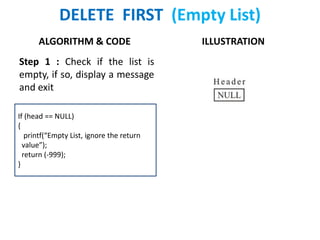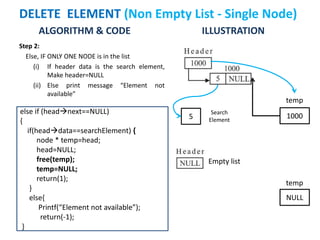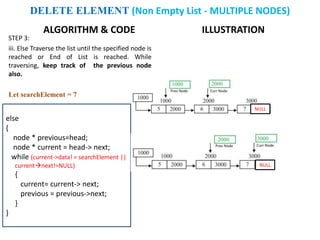1. 4 Singly linked list deletion
- 1. DATA STRUCTURES Dr. P. Subathra Professor Dept. of Information Technology KAMARAJ College of Engineering & Technology
- 2. CS8391 – DATA STRUCTURES ONLINE CLASSES – CLASS NO. 4 21.08.2020 (10:00 AM – 11:00 AM & 11:30 AM – 12:30 PM)
- 3. UNIT 1 SINGLY LINKED LIST
- 5. HEAP 1001 1002 1003 1004 1005 1006 1007 1008 1009 1010 1011 1012 1013 1014 1015 1016 1017 1018 1019 1020 1021 1022 1023 1024 1025 1026 1027 1028 1029 1030 1031 1032 1033 1034 1035 1036 1037 1038 1039 1040 1041 1042 1043 1044 1045 1046 1047 1048 1049 1050 LOOK CLOSER……
- 6. HEAP 1001 1002 1003 1004 1005 1006 1007 1008 1009 1010 1011 1012 1013 1014 1015 1016 1017 1018 1019 1020 1021 1022 1023 1024 1025 1026 1027 1028 1029 1030 1031 1032 1033 1034 1035 1036 1037 1038 1039 1040 1041 1042 1043 1044 1045 1046 1047 1048 1049 1050 LOOK CLOSER……
- 7. 1001 1002 1003 1004 1005 1006 1007 1008 1009 1010 1011 1012 1013 1014 1015 1016 1017 1018 1019 1020 1021 1022 1023 1024 1025 1026 1027 1028 1029 1030 1031 1032 1033 1034 1035 1036 1037 1038 1039 1040 1041 1042 1043 1044 1045 1046 1047 1048 1049 1050 HEAP
- 8. 1001 1002 1003 1004 1005 1006 1007 1008 1009 1010 1011 1012 1013 1014 1015 1016 1017 1018 1019 1020 1021 1022 1023 1024 1025 1026 1027 1028 1029 1030 1031 1032 1033 1034 1035 1036 1037 1038 1039 1040 1041 1042 1043 1044 1045 1046 1047 1048 1049 1050 HEAP
- 9. 1001 1002 1003 1004 1005 1006 1007 1008 1009 1010 1011 1012 1013 1014 1015 1016 1017 1018 1019 1020 1021 1022 1023 1024 1025 1026 1027 1028 1029 1030 1031 1032 1033 1034 1035 1036 1037 1038 1039 1040 1041 1042 1043 1044 1045 1046 1047 1048 1049 1050 HEAP
- 10. 1001 1002 1003 1004 1005 1006 1007 1008 1009 1010 1011 1012 1013 1014 1015 1016 1017 1018 1019 1020 1021 1022 1023 1024 1025 1026 1027 1028 1029 1030 1031 1032 1033 1034 1035 1036 1037 1038 1039 1040 1041 1042 1043 1044 1045 1046 1047 1048 1049 1050 HEAP
- 11. 1001 1002 1003 1004 1005 1006 1007 1008 1009 1010 1011 1012 1013 1014 1015 1016 1017 1018 1019 1020 1021 1022 1023 1024 1025 1026 1027 1028 1029 1030 1031 1032 1033 1034 1035 1036 1037 1038 1039 1040 1041 1042 1043 1044 1045 1046 1047 1048 1049 1050 HEAP
- 12. 1001 1002 1003 1004 1005 1006 1007 1008 1009 1010 1011 1012 1013 1014 1015 1016 1017 1018 1019 1020 1021 1022 1023 1024 1025 1026 1027 1028 1029 1030 1031 1032 1033 1034 1035 1036 1037 1038 1039 1040 1041 1042 1043 1044 1045 1046 1047 1048 1049 1050 free() HEAP
- 13. Operations on a Singly Linked List • Creating a new list • Insertion - at the beginning - at the end - after and element - before an element • Deletion - at the beginning - at the end - a given element - at a position • Display • Search Element • Reverse List • Sort List • Find Duplicates • ………………
- 14. DELETE FIRST
- 15. ALGORITHM Step 1 : Check if the list is empty, if so, display a message and exit Step 2: Else, store the data value of the first nodes in a variable for returning. Step 3 : Make the header to point to the next field of the first node. Step 4 : Delete the first node to free the memory occupied by it. SAME ALGORITHM WORKS • Case 1 – Delete from an Empty List • Case 2 – Delete from a Non Empty List DELETE FIRST
- 16. ALGORITHM & CODE Step 1 : Check if the list is empty, if so, display a message and exit ILLUSTRATION DELETE FIRST (Empty List) If (head == NULL) { printf(“Empty List, ignore the return value”); return (-999); }
- 17. ALGORITHM & CODE Step 2: Else, store the data value of the first nodes in a variable for returning. Step 3 : Make the header to point to the next field of the first node. ILLUSTRATION DELETE FIRST : Non Empty List (Single Node) else { // X is an integer variable X= headdata; head=headnext return (X); } Empty list 5X
- 18. 1001 1002 1003 1004 1005 1006 1007 1008 1009 1010 1011 1012 1013 1014 1015 1016 1017 1018 1019 1020 1021 1022 1023 1024 1025 1026 1027 1028 1029 1030 1031 1032 1033 1034 1035 1036 1037 1038 1039 1040 1041 1042 1043 1044 1045 1046 1047 1048 1049 1050 HEAP
- 19. ALGORITHM & CODE Step 2: Else, store the data value of the first nodes in a variable for returning. Step 3 : Make the header to point to the next field of the first node. Step 4 : Delete the first node to free the memory occupied by it. ILLUSTRATION else { X= headdata; // X is an integer variable node * temp = head; head=headnext; free(temp); temp=NULL; return (X); } Empty list 5 X temp 1000 NULL temp DELETE FIRST : Non Empty List (Single Node)
- 20. 1001 1002 1003 1004 1005 1006 1007 1008 1009 1010 1011 1012 1013 1014 1015 1016 1017 1018 1019 1020 1021 1022 1023 1024 1025 1026 1027 1028 1029 1030 1031 1032 1033 1034 1035 1036 1037 1038 1039 1040 1041 1042 1043 1044 1045 1046 1047 1048 1049 1050 HEAP 1036 temp
- 21. 1001 1002 1003 1004 1005 1006 1007 1008 1009 1010 1011 1012 1013 1014 1015 1016 1017 1018 1019 1020 1021 1022 1023 1024 1025 1026 1027 1028 1029 1030 1031 1032 1033 1034 1035 1036 1037 1038 1039 1040 1041 1042 1043 1044 1045 1046 1047 1048 1049 1050 HEAP 1036 temp NULL
- 22. ALGORITHM & CODE Step 2: Else, store the data value of the first nodes in a variable for returning. Step 3 : Make the header to point to the next field of the first node. Step 4 : Delete the first node to free the memory occupied by it. ILLUSTRATION DELETE FIRST : Non Empty List (Multiple Nodes) else { X= headdata; // X is an integer variable node * temp = head; head=headnext; free(temp); temp=NULL; return (X); } 5 X temp 1000 NULL temp
- 23. DELETE LAST
- 24. DELETE LAST Step 1 : Check if the list is empty, if so, display a message and exit Step 2: Else, if only one node available in the list, store the data value of that nodes in a variable for returning. Step 3 : Make the header NULL Step 4 : Delete the first node to free the memory occupied by it. SAME ALGORITHM WORKS • Case 1 – Delete an Empty List • Case 2 – Delete from a Non Empty List Operations on a Singly Linked List
- 25. ALGORITHM & CODE Step 1 : Check if the list is empty, if so, display a message and exit ILLUSTRATION DELETE LAST : Empty List If (head == NULL) { printf(“Empty List, ignore the return value”); return (-999); }
- 26. ALGORITHM & CODE Step 2: (i) Else, IF ONLY ONE NODE is in the list, store the data value of the first nodes in a variable for returning. (ii) Make the header to point to the next field of the first node. (iii) Delete the first node to free the memory occupied by it. ILLUSTRATION DELETE LAST (Non Empty List - Single Node) else if (headnext==NULL) { X= headdata; // X is an integer variable node * temp = head; head=headnext; free(temp); temp=NULL; return (X); } Empty list 5 X temp 1000 NULL temp
- 27. ALGORITHM & CODE Step 3: (i) Else, traverse till the last node keeping track of the previous node. (Eg. 8) ILLUSTRATION else { node * previous=head; node * current = head-> next; while (current->next!=NULL) { current= current-> next; previous = previous->next; } } DELETE LAST: (MULTIPLE NODES)
- 28. ALGORITHM & CODE STEP 3: ii. Store the value pointed by CURRENT in a variable for returning. iii. Make NEXT field of PREVIOUS node to be NULL iv. Free the memory occupied by the last node. ILLUSTRATION DELETE LAST (MULTIPLE NODES) else { node * previous=head; node * current = head-> next; while (current->data! = element || current->next!=NULL) { current= current-> next; previous = previous->next; } X = currentdata; previousnext =NULL; free(current); current=NULL; } 8X NULL NULL
- 29. DELETE ELEMENT
- 30. ALGORITHM & CODE Step 1 : Check if the list is empty, if so, display a message and exit ILLUSTRATION DELETE ELEMENT (Empty List) If (head == NULL) { printf(“Empty List, Element not available ignore the return value”); return (-1); }
- 31. ALGORITHM & CODE Step 2: Else, IF ONLY ONE NODE is in the list (i) If header data is the search element, Make header=NULL (ii) Else print message “Element not available” ILLUSTRATION DELETE ELEMENT (Non Empty List - Single Node) else if (headnext==NULL) { if(headdata==searchElement) { node * temp=head; head=NULL; free(temp); temp=NULL; return(1); } else{ Printf(“Element not available”); return(-1); } Empty list 5 Search Element temp 1000 NULL temp
- 32. ALGORITHM & CODE STEP 3: iii. Else Traverse the list until the specified node is reached or End of List is reached. While traversing, keep track of the previous node also. Let searchElement = 7 ILLUSTRATION else { node * previous=head; node * current = head-> next; while (current->data! = searchElement || currentnext!=NULL) { current= current-> next; previous = previous->next; } } DELETE ELEMENT (Non Empty List - MULTIPLE NODES)
- 33. ALGORITHM & CODE STEP 3: iii. Else Traverse the list until the specified node is reached or End of List is reached. While traversing, keep track of the previous node also. Let searchElement = 7 ILLUSTRATION else { node * previous=head; node * current = head-> next; while (current->data! = searchElement || current->next!=NULL) { current= current-> next; previous = previous->next; } prevnext=currentnext; free(current); current=NULL; } DELETE ELEMENT(Non Empty List - MULTIPLE NODES) NULL
- 34. ALGORITHM & CODE STEP 3: iii. Else Traverse the list until the specified node is reached or End of List is reached. While traversing, keep track of the previous node also. Let searchElement = 7 ILLUSTRATION else { node * previous=head; node * current = head-> next; while (current->data! = searchElement || currentnext!=NULL) { current= current-> next; previous = previous->next; } } DELETE ELEMENT (Non Empty List - MULTIPLE NODES) NULL NULL
- 35. ALGORITHM & CODE STEP 3: iii. Else Traverse the list until the specified node is reached or End of List is reached. While traversing, keep track of the previous node also. Let searchElement = 7 ILLUSTRATION else { node * previous=head; node * current = head-> next; while (current->data! = searchElement || current->next!=NULL) { current= current-> next; previous = previous->next; } prevnext=currentnext; free(current); current=NULL; } DELETE ELEMENT(Non Empty List - MULTIPLE NODES) NULL NULL NULL NULL
- 37. ALGORITHM & CODE Step 1 : Check if the list is empty, if so, display a message and exit ILLUSTRATION DELETE POSITION (Empty List) If (head == NULL) { printf(“Empty List, Element not available ignore the return value”); return (-1); }
- 38. ALGORITHM & CODE ILLUSTRATION DELETE POSITION (Non Empty List - Single Node) else if (k == 1) { node * temp=head; int X = headdata; head= headnext; free(temp); temp=NULL; return(X); } Empty list 5 Element at Position 1000 tempX Step 2: Let k = POSITION Else if (k== 1) (i) Store the element of the first node to return (ii) Make header to point to the second node (iii) Free the memory occupied by first node 1000 temp NULL NULL
- 39. ALGORITHM & CODE Step 2: Let k = POSITION Else if (k== 1) (i) Store the element of the first node to return (ii) Make header to point to the second node (iii) Free the memory occupied by first node ILLUSTRATION DELETE POSITION (Non Empty List -Multiple Nodes) else if (k == 1) { node * temp=head; int X = headdata; head= headnext; free(temp); temp=NULL; return(X); } 5 1000 X temp temp NULL
- 40. ALGORITHM & CODE STEP 3: iii. Else Traverse the list until the specified POSITION is reached or End of List is reached. While traversing, keep track of the previous node also. Let, POSITION =3 ILLUSTRATION else { count =2, node * previous=head; node * current = head-> next; while (count < POSITION || currentnext!=NULL) { current= current-> next; previous = previous->next; count++; } } DELETE POSITION (Non Empty List - MULTIPLE NODES) Count =2 Count =3
- 41. STEP 3: iv. If position is a valid position, store the value of that node for returning v. Make the previous node to point to the POSITION node’s next pointer value ILLUSTRATION else { count =2, node * previous=head; node * current = head-> next; while (count < POSITION || currentnext!=NULL) { current= current-> next; previous = previous->next; count++; } if (count == POSITION) { prevnext=currentnext; X = currentdata; free(current); current=NULL; return (X); } } DELETE POSITION (Non Empty List - MULTIPLE NODES) NULL ALGORITHM & CODE
- 42. STEP 3: vi. Else if POSITION is not available, Print a message and return -1. Eg. POSITION = 5 ILLUSTRATION else { count =2, node * previous=head; node * current = head-> next; while (count < POSITION || currentnext!=NULL) { current= current-> next; previous = previous->next; count++; } if (count == POSITION) { prevnext=currentnext; X = currentdata; free(current); current=NULL; return (X); } else { Printf (“Position not available”); return (-1); } } DELETE POSITION (Non Empty List - MULTIPLE NODES) ALGORITHM & CODE Count =5
- 44. PRINT THE LIST












































